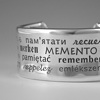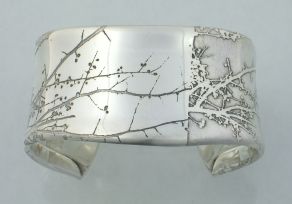SANDRA NOBLE GOSS
1946-2022Home | Portfolio | About | Tech Notes
Technical Notes: Etching Sterling Silver
This is an archived page.

ETCHING STERLING SILVER WITH FERRIC NITRATE:
©Sandra Noble Goss[These advanced techniques assume that you have basic jewellery and metalworking skills. We offer these technical papers, originally presented as workshops, in a spirit of sharing information. We assume no liability for safety and health issues -- those are your responsibility. Please ask for the MSDS (Material Safety Data Sheets) for the materials when you buy them.]
This method of etching uses a ferric nitrate solution which also contains nitric acid. This "etchant" is not a pure acid, but etches fine silver and sterling silver (ferric chloride will not etch silver).
CAUTION: Although etchant is not a pure acid, it is a "corrosive poison". Read the label: avoid contact with eyes and skin, use with adequate ventilation.
MATERIALS:
- "Etchant" (ferric nitrate solution of ferric nitrate crystal + distilled water)
- selection of permanent markers or tapes for resist; other waterproof resists (see notes)
- glass or plastic container with lid, big enough to hold piece of metal
- baking soda (bicarbonate of soda)
- emery paper (fine) or superfine steel wool, or brass brush
- methyl hydrate
- rubber gloves, plastic tweezers
Sterling silver can be etched with ferric nitrate using the same resists that are used with ferric chloride when etching copper or copper alloys. It is safer to use than nitric acid solutions. Ferric Nitrate is available only from a chemical supplier (for example, Nymoc in Toronto). It comes in crystal form (resembles large sugar crystals with a slight mauve tint).

Etched sterling bracelet, Sandra Noble Goss
RECIPE:
The following recipe seems to work well (taking up to 2 to 4 hours to etch deeply enough).
- 400 ml distilled water
- 300 g ferric nitrate
- 1 tsp. old nitrate acid solution (1: 5 solution) to 'kick start' the solution.
- Add the crystals to the water * contained in a Pyrex or plastic container and mix with a plastic spoon.
SAFETY PRECAUTIONS:
Mix under a fume hood. No fumes seem to be given off when the
etchant is working, but it is always wise to work under a hood or in a well-ventilated space.
* ALWAYS ADD THE FERRIC NITRATE TO THE WATER - the same as mixing acids.
Use rubber gloves and protective clothing. Ferric Nitrate will make a persistant stain on skin.
Neutralize ferric nitrate with Baking Soda [also see Ferric Chloride notes]
RESISTS:
See notes on Ferric Chloride etching. Read them first. Ferric nitrate works much the same way, only takes longer to etch. Safety precautions are much the same as for Ferric Chloride.
- Permanent markers (follow instructions in Ferric Chloride etching notes). Because metal remains in the solution for such a long time, the ink can lift off. Make certain the metal is absolutely clean, with the appropriate finish.
- Tape - Brown or clear cello type tape eg. packing tape(see Ferric Chloride notes).
- PnP Blue Film - Photocopy resists (see notes on PnP Blue and Ferric Chloride) This seems the most reliable method to use with ferric nitrate as it stands up better than pen ink to the long immersion in the solution.
- Liquid Floor Polish ("Future") - this makes a good resist for silver as it does not lift off in the solution. It can be painted on with a brush, or flushed across the entire surface of the metal, and scratched through with a scriber - wait about 20 minutes before scratching designs.
- Nail Polish and waterproof paints.
ETCHING PROCESS:
 Put etchant in glass or plastic container. Read the label for safety precautions. Submerge piece into etchant with the design facing down (to allow particles of silver to fall away and not interfere with the etching process). It is best to suspend the piece in the solution, so it is clear of the bottom of the container. Either hang the piece from a wire strung across the container (you can make a tab of tape to attach to the wire) or tape onto pieces of plastic foam (e.g. Styrofoam) to float the metal above the bottom. Agitate the solution frequently by gently knocking the edge of the container or placing it on top a small motor that vibrates - like a bubbler for an aquarium.
Put etchant in glass or plastic container. Read the label for safety precautions. Submerge piece into etchant with the design facing down (to allow particles of silver to fall away and not interfere with the etching process). It is best to suspend the piece in the solution, so it is clear of the bottom of the container. Either hang the piece from a wire strung across the container (you can make a tab of tape to attach to the wire) or tape onto pieces of plastic foam (e.g. Styrofoam) to float the metal above the bottom. Agitate the solution frequently by gently knocking the edge of the container or placing it on top a small motor that vibrates - like a bubbler for an aquarium.
IMPORTANT: When the piece is etched to the desired depth, remove the piece and wash immediately with water and scrub with an old toothbrush or brass brush and baking soda (or ammonia solution). The baking soda will neutralize the etchant and stop the etching action. If the etchant is not completely neutralized, it will continue its etching action.
Remove the ink with alcohol:
Remove Staedtler inks with methyl hydrate [a.k.a. denatured alcohol] Wear rubber or latex gloves and use in well ventilated area.
TIME:
My early experiments have taken about 4 hours to achieve the depth of etch I wished. Older solutions can take up to seven hours which makes it more important to use a strong resist such as PnP Blue. A newer solution may work in 2 hours. You must check the depth of etch regularly - say every hour or so. If it is possible to warm the solution, that may cause it to work more quickly. Agitation may help. You may also add a small quantity of citric acid which may enhance the etching (I am presently experimenting with this and will add notes, when the experiment is completed).

"Branches": photoetched sterling bracelet. Sandra Noble Goss.
|
SAFETY PRECAUTIONS: Always use Etchant in well ventilated area (preferably under a fume hood).
DO NOT INHALE FUMES! Read the label on the bottle. |
©Sandra Noble Goss
TECHNICAL NOTES
Etching
Silver Etching
Photocopy Resist
Roller Printing
Multi-metal Lamination